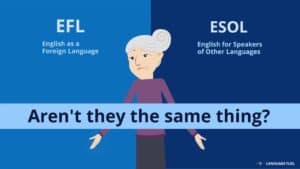What are EFL, ESL and ESOL? How do they Differ?

In the field of language learning, particularly English, three acronyms often come into play – EFL, ESL, and ESOL. They represent the different approaches and contexts in which English is taught to non-native speakers.
EFL, or English as a Foreign Language, refers to the teaching and learning of English in a non-English speaking country. In an EFL context, English is not the primary language of daily life or communication. The primary motivation for learning English in an EFL setting is often for educational purposes, such as to pass exams, or for professional advancement like working in multinational corporations or travelling internationally. Examples of EFL contexts include countries like Japan, Brazil, or Russia where the primary language is not English.
ESL, or English as a Second Language, is a term often used in English-speaking countries, referring to the teaching and learning of English by individuals who have different first languages. These individuals are typically immigrants, refugees, or international students who need to learn English to integrate into their new environment. English is learned and used as a means of communication in the community or workplace. ESL programs typically focus more on the practical usage of English in everyday life.
ESOL, or English for Speakers of Other Languages, is a term that has become increasingly common in education and immigration policy circles. It is a more inclusive term, covering both the EFL and ESL contexts. It emphasizes the fact that many individuals learning English often already speak several other languages, thus English may not be their ‘second’ language, but perhaps their third or fourth. ESOL programs are often designed to equip students with the English skills necessary to succeed in academic, professional, and social settings in English-speaking contexts.
The differences between EFL, ESL, and ESOL largely lie in the learners’ contexts and needs. While EFL learners need English primarily for educational or professional reasons in a non-English-speaking environment, ESL learners need English for survival and integration into an English-speaking society. ESOL is a more encompassing term, recognizing the diverse language backgrounds of English learners and the various reasons for their study.
Understanding these terms is not only crucial for language educators in designing appropriate curriculum and learning strategies, but also for policy makers in developing effective language policies that cater to the diverse needs of English learners across the globe.
Regenerate response
